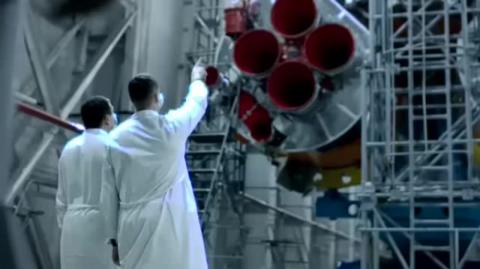GAME OVER! Tesla's SECRET WEAPON The Gigapress
Tesla has invested a lot in its Giga Presses and continues to do so. But do those massive machines give it an edge over the competition, and how much edge?
Tesla as company is used to doing big things, which makes it not surprising that Giga Presses would be found in its factories. These are huge by all standards, most likely dwarfing your apartment.
A Giga Press is a die casting machine, among the most powerful ever built with capacity of 61 kilo newton clamping forces. They weigh more than 400 tonnes and require more than 20 flatbed trucks to transport only one. They measure 20 meters by 7.5 meters by 6 meters.
They are made by the Italian manufacturing group known as IDRA and the company has enjoyed Tesla’s patronage more than a few times, with what we heard to be current multiple orders yet to be fulfilled.
Interestingly, even though the name Giga Press goes with Tesla’s Gigafactory, the name was actually coined by IDRA.
How Giga Presses work
Tesla uses the Giga Press to make the chassis in its cars in single pieces. This means the automaker deals with at most three parts instead of more than a hundred if it had followed the practice of bolting and welding stuff together like the auto industry has been doing since forever.
A Giga Press works like just any other die casting machine, as they use a plunger to force hot molten metal into a mold that will be reused. The impressive difference is the scale at which a Giga Press does it.
To get a fair idea, take a plastic toy car for example. The cheaper ones are usually made from a single solid piece before the tires are tacked on. Now imagine the whole chassis of a car made in the same way, but this time, made from metal.
The chassis will be at most 3-piece, comprising the front and rear sections joined by a battery pack structure.
The making of a vehicle chassis with a Giga Press takes place in different stages. The preparation step involves spraying Soybeans oil into the mold, which is needed to make it easy to remove the finished chassis easily. This is important for the mold to be easily reusable.
The metal is melted using a furnace external to the Giga Press. Tesla combines aluminium and silicon to make its chassis, which technically means it is an alloy. The alloy melts at around 850 degrees Celsius, after which the right amount is forced into the mold by the plunger.
After cooling down to 400 degrees Celsius, the mold is opened and the chassis is moved by a robot into a pool of water for further cooling to 50 degree Celsius.
Lastly, the chassis will be checked for defects and rough edges trimmed, after which all the required holes will be drilled in by robots.
How the Giga Press crushes the competition
Giga presses require a lot of investments and space for installation, so Tesla must have seen the clear benefits before committing to them.
The fact is the Giga Press is a game changer in the auto industry.
The most obvious advantage is speed because despite their great proportions, they work very fast.
Per IDRA specs, the aluminum silicon alloy can go from molten metal to a chassis in less than a hundred seconds. That’s a blithering speed when you compare that to all the steps and labour involved in fabricating and then fastening more than 100 parts together.
Tesla has invested a lot in its Giga Presses and continues to do so. But do those massive machines give it an edge over the competition, and how much edge?
Tesla as company is used to doing big things, which makes it not surprising that Giga Presses would be found in its factories. These are huge by all standards, most likely dwarfing your apartment.
A Giga Press is a die casting machine, among the most powerful ever built with capacity of 61 kilo newton clamping forces. They weigh more than 400 tonnes and require more than 20 flatbed trucks to transport only one. They measure 20 meters by 7.5 meters by 6 meters.
They are made by the Italian manufacturing group known as IDRA and the company has enjoyed Tesla’s patronage more than a few times, with what we heard to be current multiple orders yet to be fulfilled.
Interestingly, even though the name Giga Press goes with Tesla’s Gigafactory, the name was actually coined by IDRA.
How Giga Presses work
Tesla uses the Giga Press to make the chassis in its cars in single pieces. This means the automaker deals with at most three parts instead of more than a hundred if it had followed the practice of bolting and welding stuff together like the auto industry has been doing since forever.
A Giga Press works like just any other die casting machine, as they use a plunger to force hot molten metal into a mold that will be reused. The impressive difference is the scale at which a Giga Press does it.
To get a fair idea, take a plastic toy car for example. The cheaper ones are usually made from a single solid piece before the tires are tacked on. Now imagine the whole chassis of a car made in the same way, but this time, made from metal.
0



 Billy Von Bomb
Billy Von Bomb
 LiberumArbitrium
LiberumArbitrium
 Redacted News
Redacted News
 AgentofSocialMediaChaos
AgentofSocialMediaChaos
 NerokeFive
NerokeFive
 TheSaltyCracker
TheSaltyCracker

 REDPILLMARRIED
REDPILLMARRIED
 Grims Dungeon Of Degeneracy
Grims Dungeon Of Degeneracy

 Life_N_Times_of_Shane_T_Hanson
Life_N_Times_of_Shane_T_Hanson


 Better Bachelor
Better Bachelor
 Timcast IRL
Timcast IRL


 Styxhexenhammer666
Styxhexenhammer666



Log in to comment
i know most of us think we are going to collapse, but with stuff like this going on all around the world only tells me that if we do collapse, that it won't last very long, due to automation projects like this.
inflation is happening, but if everything is made by robots, the inflation might not be much of an issue in other cases when these other jobs are filled with robots.
something like food production shortages would be a thing of the past if the job is automated. but you have to look at it from all aspects of our economy.
i mean what do you think's going to happen when every job is automated?
are we going to collapse? or will we be just fine?
however there is still this issue with the ppl taking the sheeple shot or experimental vaccine expiring soon reducing the worlds population to a certain extent.
https://upload.wikimedia.org/w....ikipedia/commons/7/7
Luddite: "More robots are replacing human!"
Industrialist: "Okay, we will use less robot (snickering)."